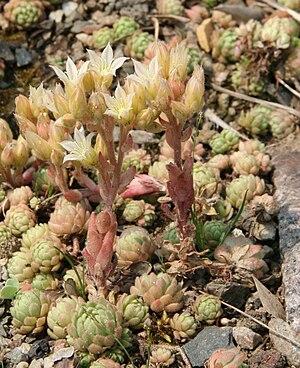Prometheum
| Prometheum | ||||||||||||
|---|---|---|---|---|---|---|---|---|---|---|---|---|

Prometheum chrysanthum |
||||||||||||
| Systematics | ||||||||||||
|
||||||||||||
| Scientific name | ||||||||||||
| Prometheum | ||||||||||||
| ( A.Berger ) H.Ohba |
Prometheum is a genus of plants fromthe thick-leaf family (Crassulaceae). The botanical name of the genus is derived from Prometheus , who according to Greek mythology is said to have brought fire tohumans. Some authors. refer to the blood-red flowers of Prometheum pilosum . Alwin Berger , the originator of the name, rather thought that these species - like Prometheus - were "forged" on rocks in the Caucasus.
description
The species of the genus Prometheum are perennial or one to two year old hapaxanthe herbaceous plants which are usually dense and finely glandular-downy hairy. Their dense rosettes are flattened-spherical with sessile, alternately arranged, succulent leaves that are flat to semi-petiolate and oblong to obovate-spatulate.
The terminal or lateral, usually strong inflorescence becomes up to 25 centimeters long, is zymös or equilibrium and consists of two to numerous, sometimes forked, coils. Each of the short-stalked, five-fold flowers has a usually tiny bract. The sepals are broadly seated. The yellow, creamy white, pink or red petals are fused together for less than half of their length. The corolla lobes are spread out to almost upright.
The fruit is a follicle fruit . The seeds it contains are elongated, egg-shaped and ribbed.
Systematics and distribution
The genus Prometheum is common in northern Greece , Turkey , Armenia , the Caucasus and northern Iran , mostly at high altitudes. According to Henk 't Hart (1944–2000) the genus Prometheum consists of the following species:
- Prometheum aizoon (Fenzl) 't Hart (Syn .: Rosularia aizoon (Fenzl) A. Berger )
- Prometheum chrysanthum (Boiss.) 'T Hart (Syn .: Rosularia chrysantha (Boiss.) Takht. )
- Prometheum muratdaghense (Kit Tan) 't Hart
- Prometheum pilosum (M. Bieb.) H. Ohba (Syn .: Sedum pilosum M. Bieb. )
- Prometheum rechingeri (C.-A. Jansson) 't Hart (Syn .: Rosularia rechingeri C.-A. Jansson )
- Prometheum sempervivoides (M. Bieb.) H. Ohba
-
Prometheum serpentinicum (Werderm.) 'T Hart (Syn .: Rosularia serpentinica (Werderm.) Muirhead ): It occurs in Asia Minor. With the varieties:
- Prometheum serpentinicum var. Giganteum (Eggli) 't Hart (Syn .: Rosularia serpentinica (Werderm.) Muirhead var. Gigantea Eggli , Chaloupkaea gigantea (Eggli) Niederle )
- Prometheum serpentinicum var. Serpentinicum
- Prometheum tymphaeum (Quézel & Contandr.) 'T Hart (Syn .: Sedum tymphaeum Quézel & Contandr. ): It occurs only in Greece. It is presented to Sedum by K. Marhold (2011).
proof
literature
- Urs Eggli (ed.): Succulent lexicon. Crassulaceae (thick leaf family) . Eugen Ulmer, Stuttgart 2003, ISBN 3-8001-3998-7 , pp. 212-218 .
Individual evidence
- ↑ Urs Eggli , Leonard E. Newton: Etymological Dictionary of Succulent Plant Names . Springer, Berlin / Heidelberg / New York 2004, ISBN 3-540-00489-0 , pp. 191-192
- ^ A. Berger : Crassulaceae . In: Adolf Engler u. Prantl: The natural plant families . 2nd edition, Volume 18a, page 459, 1930
- ↑ Henk 't Hart: Prometheum . In: Urs Eggli : Succulents Lexicon Volume 4. Crassulaceae (thick-leaf plants) . 2003, pp. 212-218
- ↑ Jaakko Jalas, Juha Suominen, Raino Lampinen, Arto Kurtto: Atlas florae europaeae . Volume 12 (Resedaceae to Platanaceae). Page 117, Helsinki 1999. ISBN 951-9108-12-2
- ↑ Karol Marhold, 2011: Crassulaceae: Datasheet Sedum tymphaeum In: Euro + Med Plantbase - the information resource for Euro-Mediterranean plant diversity.
